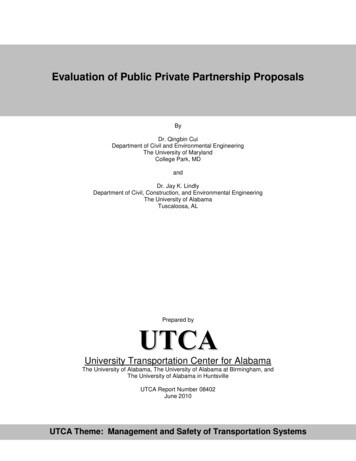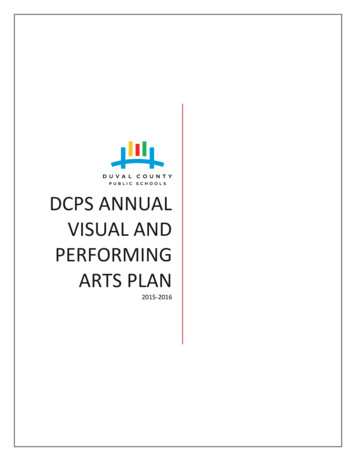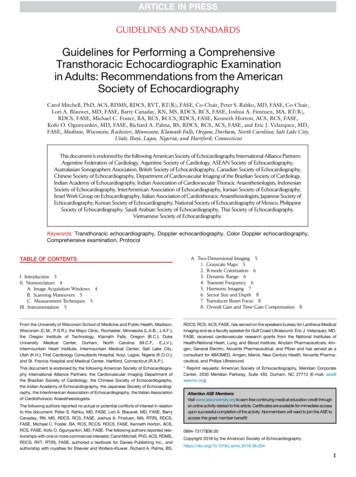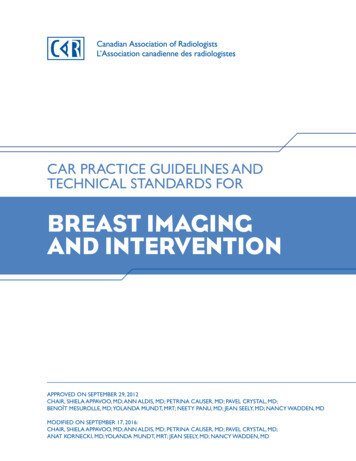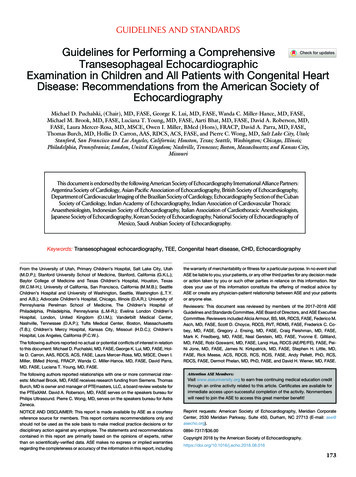
Transcription
GUIDELINES AND STANDARDSGuidelines for Performing a ComprehensiveTransesophageal EchocardiographicExamination in Children and All Patients with Congenital HeartDisease: Recommendations from the American Society ofEchocardiographyMichael D. Puchalski, (Chair), MD, FASE, George K. Lui, MD, FASE, Wanda C. Miller-Hance, MD, FASE,Michael M. Brook, MD, FASE, Luciana T. Young, MD, FASE, Aarti Bhat, MD, FASE, David A. Roberson, MD,FASE, Laura Mercer-Rosa, MD, MSCE, Owen I. Miller, BMed (Hons), FRACP, David A. Parra, MD, FASE,Thomas Burch, MD, Hollie D. Carron, AAS, RDCS, ACS, FASE, and Pierre C. Wong, MD, Salt Lake City, Utah;Stanford, San Francisco and Los Angeles, California; Houston, Texas; Seattle, Washington; Chicago, Illinois;Philadelphia, Pennsylvania; London, United Kingdom; Nashville, Tennessee; Boston, Massachusetts; and Kansas City,MissouriThis document is endorsed by the following American Society of Echocardiography International Alliance Partners:Argentina Society of Cardiology, Asian-Pacific Association of Echocardiography, British Society of Echocardiography,Department of Cardiovascular Imaging of the Brazilian Society of Cardiology, Echocardiography Section of the CubanSociety of Cardiology, Indian Academy of Echocardiography, Indian Association of Cardiovascular ThoracicAnaesthesiologists, Indonesian Society of Echocardiography, Italian Association of Cardiothoracic Anesthesiologists,Japanese Society of Echocardiography, Korean Society of Echocardiography, National Society of Echocardiography ofMexico, Saudi Arabian Society of Echocardiography.Keywords: Transesophageal echocardiography, TEE, Congenital heart disease, CHD, EchocardiographyFrom the University of Utah, Primary Children’s Hospital, Salt Lake City, Utah(M.D.P.); Stanford University School of Medicine, Stanford, California (G.K.L.);Baylor College of Medicine and Texas Children’s Hospital, Houston, Texas(W.C.M-H.); University of California, San Francisco, California (M.M.B.); SeattleChildren’s Hospital and University of Washington, Seattle, Washington (L.T.Y.and A.B.); Advocate Children’s Hospital, Chicago, Illinois (D.A.R.); University ofPennsylvania Perelman School of Medicine, The Children’s Hospital ofPhiladelphia, Philadelphia, Pennsylvania (L.M-R.); Evelina London Children’sHospital, London, United Kingdom (O.I.M.); Vanderbilt Medical Center,Nashville, Tennessee (D.A.P.); Tufts Medical Center, Boston, Massachusetts(T.B.); Children’s Mercy Hospital, Kansas City, Missouri (H.D.C.); Children’sHospital, Los Angeles, California (P.C.W.).The following authors reported no actual or potential conflicts of interest in relationto this document: Michael D. Puchalski, MD, FASE, George K. Lui, MD, FASE, Hollie D. Carron, AAS, RDCS, ACS, FASE, Laura Mercer-Rosa, MD, MSCE, Owen I.Miller, BMed (Hons), FRACP, Wanda C. Miller-Hance, MD, FASE, David Parra,MD, FASE, Luciana T. Young, MD, FASE.The following authors reported relationships with one or more commercial interests: Michael Brook, MD, FASE receives research funding from Siemens. ThomasBurch, MD is owner and manager of PTEmasters, LLC, a board review website forthe PTEeXAM. David A. Roberson, MD, FASE serves on the speakers bureau forPhilips Ultrasound. Pierre C. Wong, MD, serves on the speakers bureau for AstraZeneca.NOTICE AND DISCLAIMER: This report is made available by ASE as a courtesyreference source for members. This report contains recommendations only andshould not be used as the sole basis to make medical practice decisions or fordisciplinary action against any employee. The statements and recommendationscontained in this report are primarily based on the opinions of experts, ratherthan on scientifically-verified data. ASE makes no express or implied warrantiesregarding the completeness or accuracy of the information in this report, includingthe warranty of merchantability or fitness for a particular purpose. In no event shallASE be liable to you, your patients, or any other third parties for any decision madeor action taken by you or such other parties in reliance on this information. Nordoes your use of this information constitute the offering of medical advice byASE or create any physician-patient relationship between ASE and your patientsor anyone else.Reviewers: This document was reviewed by members of the 2017–2018 ASEGuidelines and Standards Committee, ASE Board of Directors, and ASE ExecutiveCommittee. Reviewers included Alicia Armour, BS, MA, RDCS, FASE, Federico M.Asch, MD, FASE, Scott D. Choyce, RDCS, RVT, RDMS, FASE, Frederick C. Cobey, MD, FASE, Gregory J. Ensing, MD, FASE, Craig Fleishman, MD, FASE,Mark K. Friedberg, MD, FASE, Neal Gerstein, MD, FASE, Yvonne E. Gilliland,MD, FASE, Robi Goswami, MD, FASE, Lanqi Hua, RDCS (AE/PE/FE), FASE, PeiNi Jone, MD, FASE, James N. Kirkpatrick, MD, FASE, Stephen H. Little, MD,FASE, Rick Meese, ACS, RDCS, RCS, RCIS, FASE, Andy Pellett, PhD, RCS,RDCS, FASE, Dermot Phelan, MD, PhD, FASE, and David H. Wiener, MD, FASE.Attention ASE Members:Visit www.aseuniversity.org to earn free continuing medical education creditthrough an online activity related to this article. Certificates are available forimmediate access upon successful completion of the activity. Nonmemberswill need to join the ASE to access this great member benefit!Reprint requests: American Society of Echocardiography, Meridian CorporateCenter, 2530 Meridian Parkway, Suite 450, Durham, NC 27713 (E-mail: ase@asecho.org).0894-7317/ 36.00Copyright 2018 by the American Society of 18.08.016173
174 Puchalski et alAbbreviations2D Two-DimensionalJournal of the American Society of EchocardiographyFebruary 2019INTRODUCTIONSince its introduction nearlyfour decades ago, transesopha3D Three-Dimensionalgeal echocardiography (TEE)ACHD Adult Congenitalhas witnessed a remarkableHeart Diseaseevolution.Theimportantstrides made in improving TEEASE/SCA Americantechnology – including develSociety of Echocardiography/Society of Cardiovascularopment of multiplane phasedAnesthesiologistsarray transducers, matrix arraytransducersforthreeAoV Aortic Valvedimensional (3D) imaging, andAsc Ao Ascending Aortaextensive improvements inechocardiographicimagingCA Coronary Arteryplatform technology – haveCHD Congenital Heartcatalyzed the establishment ofDiseaseTEE as a critically important cardiovascular imaging modality.1-15DTG Deep TransgastricThe esophageal position of theIVC Inferior Vena Cavaultrasonic transducer providesLA Left Atriumsuperior cardiac imaging andallows monitoring of the heartLAX Long Axisbefore, during, and after cardiacLV Left Ventricleornon-cardiacprocedureswithout interruption.LVOT Left VentricularTEE in the pediatric populaOutflow Tracttion became widespread afterME Midesophagealthe introduction of commerciallyavailable miniaturized probes inMV Mitral Valvethe late 1980s.1-3 Since then,PA Pulmonary Arterythe safety and invaluable clinicalutility of this technique forPV Pulmonary Valvemany types of pediatric andRA Right Atriumadult congenital cardiac surgeryRV Right Ventricleandcardiacinterventionalprocedures has become wellRVOT Right Ventricularestablished.4-15 The increasingOutflow Tractapplications of TEE coupledSAX Short Axiswith newer technology ledthe American Society ofSVC Superior Vena CavaEchocardiographyandtheTG ts(ASE/SCA)TTE Transthoracicto publish the most recentEchocardiographyrecommendationsforaTEE ographyin 2013 geared primarily toTV Tricuspid Valveadult patients with structurallynormal hearts.16UE Upper EsophagealSimilarly, pediatric TEE hasincorporated the use of 3Dtechnology and exploited the advances in probe and softwaretechnology, leading to the need for a position document to update the current state-of-the-art for pediatric and congenital cardiology.12,17-32 The current document was written to provideguidelines for the use of TEE, and recommendations forstandardized TEE views and techniques that can be used in theassessment of children or any patient with congenital heartdisease (CHD).Table 1 Indications for TEE in the patient with CHDDiagnostic Indications Patient with suspected CHD and non-diagnostic TTE Presence of patent foramen ovale (PFO) with and without agitatedsaline contrast and direction of shunting as possible etiology forstroke Evaluation for cardiovascular source of embolus with no identifiednon-cardiac source Evaluation of intra- or extra-cardiac baffles following the Fontan,Senning, or Mustard procedure Suspected acute aortic pathology including but not limited todissection/transection (e.g., Marfan syndrome, bicuspid aorticvalve, coarctation of the aorta) Intra-cardiac evaluation for vegetation or suspected abscess Evaluation for intra-cardiac thrombus prior to cardioversion foratrial flutter/fibrillation and/or radiofrequency ablation Pericardial effusion or cardiac function evaluation and monitoringpostoperative patient with open sternum or poor acousticwindows Evaluating status of prosthetic valve in the setting of inadequateTTE images Re-evaluation of prior TEE finding for interval change (e.g.,resolution of thrombus after anticoagulation, resolution ofvegetation after antibiotic therapy)Perioperative Indications Immediate preoperative definition of cardiac anatomy andfunction Postoperative surgical results and function Intraoperative monitoring of ventricular volume and function Monitoring of intra-cardiac/intravascular air and adequacy ofcardiac de-airingTEE-guided Interventions Guidance for placement of occlusion device (e.g., septal defect,Fontan or intra-atrial baffle fenestration) Guidance for blade or balloon atrial septostomy Guidance for creation/stenting of interventricular communication Guidance during percutaneous valve interventions Guidance during radiofrequency ablation procedure Assessment of results of minimally invasive surgical incision orvideo-assisted cardiac procedure Guidance during placement of catheter-based cardiac assistdevice (e.g., Impella â heart pump)Modified from Ayres et al.31GENERAL GUIDELINESIndications and Contraindications for TEEIndications in the Pediatric Patient. TEE in children iscommonly used for the assessment of anatomy and function duringcardiac surgery, typically for CHD (Table 1).11,31 However, due tocertain inherent limitations in the imaging of key cardiac structures(discussed below), it should not serve as the sole or primarydiagnostic modality for assessment of pediatric heart disease. Instead,thetask force recommends preoperativetransthoracicechocardiography (TTE) for all children undergoing cardiac surgeryas it may provide information unobtainable with intraoperative TEEalone. Intraoperative TEE performed immediately prior to thesurgical intervention allows the operative team to review thepreoperative diagnostic findings, identify any new findings, and assistin the assessment of hemodynamics and myocardial function priorto onset of the operative procedure. TEE may facilitate catheterplacement, real-time monitoring of volume status and myocardial
Puchalski et al 175Journal of the American Society of EchocardiographyVolume 32 Number 2function in order to inform selection of anesthetic agents, inotropicsupport, and management decisions.33-36 In the intraoperativesetting, TEE can be used to assess cannula position and venousdrainage during cardiopulmonary bypass, facilitate intra-cardiac deairing, and characterize rhythm disturbances. An important role ofthe post-intervention TEE is to evaluate the adequacy of the surgicalrepair and assess ventricular function. However, it should be recognized that the postoperative TEE findings could be influenced by anumber of factors such as anesthetic depth, hemodynamic state, andvasoactive drug administration. Decisions to return to bypass, therefore, should consider not only the TEE findings, but also clinical information, hemodynamics, and the risk versus benefit of a re-intervention.TEE serves an important role in the cardiac catheterization laboratory.37-39 During placement of septal closure devices, TEE providesprecise identification of the location, geometry, and number ofdefects, allowing the interventionalist to develop clear strategies forclosure.40-42 TEE use during catheter-based procedures limits fluoroscopy time, decreases contrast load, and improves the overall safety ofthe interventions.38,39,43,44Outside of the procedural setting, TEE is used to provide diagnosticimages when the patient has poor acoustic windows, if TTE is nondiagnostic, or in cases where TEE imaging has proven superior,such as evaluation for atrial thrombi prior to cardioversion, assessment for intra-cardiac shunting in patients with a cerebrovascular accident, visualization of the Fontan pathway, assessment of prostheticvalve function and associated pathology, and evaluation of endocarditis on both native and prosthetic valves.33-35,45-48Intraoperative TEE use is increasing for monitoring myocardial function and ventricular loading conditions in patients with CHD and otheracquired pathologies undergoing high-risk non-cardiac procedures, aswell as for the visualization of landmark structures during minimallyinvasive surgery.36,49-54 In the intensive care unit, TEE providesdiagnostic information in the postoperative patient with suboptimaltransthoracic windows or an open sternum, and in the managementof patients undergoing mechanical circulatory support.46,55-57Indications in the Adult with Congenital Heart Disease(ACHD)TEE is indicated in the ACHD patient for many of the same reasons asnoted above: inadequate TTE images, guidance of cardiac interventions in the operating room or catheterization laboratory, assessmentof intra-cardiac thrombus (particularly prior to elective cardioversionor radiofrequency ablation), and for diagnosis of infective endocarditis with moderate to high pretest probability.16 TEE is often superior toTTE for assessment of interatrial shunts, anomalous pulmonaryvenous return, atrioventricular valves (AV), complex atrial baffle procedures, the Fontan pathway, prosthetic heart valves and conduits,and coronary artery anomalies.TEE may be very useful in the assessment of all ACHD patients whoare undergoing cardiac surgery for the first time and during reoperationsfor management of residual hemodynamic lesions as well as in the settingof non-cardiac surgery.58 In these settings, TEE can provide completemorphologic and functional assessment of simple to complex CHD.9Contraindications in the Pediatric PatientProbe placement and esophageal instrumentation are semi-invasiveand carry potential risks. The patient’s history should be reviewedfor relative and absolute contraindications (Table 2). If the contraindication is relative, potential benefits should outweigh the associatedrisks. For example, special consideration must be given to the patientTable 2 Contraindications to TEEAbsoluteRelativeUnrepairedtracheoesophageal fistulaEsophageal obstruction orstricturePerforated hollow viscusActive gastric or esophagealbleedingPoor airway controlSevere respiratory depressionUncooperative, unsedatedpatientHistory of esophageal orgastric surgeryHistory of esophageal cancerEsophageal varices ordiverticulumRecent gastrointestinal bleedActive esophagitis or pepticulcer diseaseVascular ring, aortic archanomaly with or withoutairway compromiseOropharyngeal pathologySevere coagulopathySignificant thrombocytopeniaCervical spine injury oranomalyPost-gastrostomy orfundoplication limit imagingto esophageal windowsModified from Ayres et al.31who has undergone esophageal surgery since it is unclear whether/when probe placement is safe. The risk/benefit ratio of TEE after gastrostomy tube/button placement (with or without associated Nissenfundoplication) might require limiting or avoiding imaging from thestomach (transgastric or deep transgastric imaging). Care must betaken in children with Down syndrome secondary to a relatively largetongue, narrow hypopharyngeal structures, and/or cervical spineinstability.59 In the pediatric patient with a vascular ring, TEE is relatively contraindicated because the esophagus and trachea areconfined to a restricted space and a rigid TEE probe in the esophaguscan produce significant airway compromise.Contraindications in the ACHD PatientAbsolute and relative contraindications to TEE in the adult are outlined in the 2013 ASE/SCA Comprehensive TEE Guidelines.16 Thesame considerations described above for the child with Down syndrome or with a vascular ring apply to the ACHD population.Key Points1. Indications for TEE in children and all patients with CHDinclude pre and postoperative evaluation of cardiac anatomyand function, guidance of transcatheter interventions, nondiagnostic TTE, intra-cardiac thrombus, prosthetic valve function, and diagnosis of infective endocarditis.12. The benefits of the procedure should outweigh the risks whenpatients with relative contraindications are evaluated for TEE.Relative contraindications primarily relate to the potential ofesophageal trauma or airway compromise (Table 2).Training and CertificationCognitive Skills, Technical Skills, and Training Guidelines. TEEimaging is considered an advanced skill, thus, it is expected that the pediatric or ACHD echocardiographer performing the study should haveexpertise in the TTE diagnosis of structural and acquired heart disease.Core pediatric echocardiography skills that include medical knowledge
176 Puchalski et alJournal of the American Society of EchocardiographyFebruary 2019Table 3 Guidelines for training and maintenance of competenceComponentObjectiveDurationNumber of casesEchocardiographyPrior experience in performing/interpreting TTE6 mo or equivalentMinimum of 450 cases across all age groupsEsophageal intubation(if part of practice)TEE probe insertionVariable25 cases (50% under 2 years of age)TEE examPerform and interpret with supervisionVariable50 casesOngoing TEE experienceMaintenance and competencyAnnual25-50 cases per year or achievement oflaboratory-established outcome variablesModified from Ayres et al.31and patient care or procedural skills as outlined in the Task Force addressing Pediatric Cardiology Fellowship Training in Noninvasive CardiacImaging are recommended for pediatric cardiologists planning toperform TEE independently (Table 3).31,60 This does not preclude acategorical fellow from starting to learn TEE skills during his/herfellowship, including but not limited to time on a simulator which canoptimize the ability to rapidly and fluidly obtain images. Evaluation ofthe anatomic and hemodynamic complexity of pediatric and ACHDpatients demands an in-depth knowledge of all congenital and acquiredpediatric cardiovascular pathologies, along with associated palliative andcorrective surgical and transcatheter procedures. In addition, a rich experience in two-dimensional (2D) 6 3D echocardiography, as well aspulsed-wave, continuous-wave, and color flow Doppler imaging techniques, is necessary.9Performance of TEE requires understanding of oropharyngeal anatomy, endoscopic techniques, and the indications, contraindications,and risks involved in the procedure, particularly if one is responsiblefor probe insertion. In small children, proper probe selection and supervision of intubation for the novice echocardiographer can mitigaterisk.61,62 The individual responsible for probe placement should beskilled in esophageal intubation. Suggested training guidelines forthose expected to be involved in probe insertion in children includethe performance of at least 25 esophageal intubations with directsupervision by an experienced pediatric echocardiographer,gastrointestinal endoscopist, or anesthesiologist, optimally in anactive, accredited, and high-volume pediatric heart center, before unsupervised probe placement in this population is considered. This supervised experience should also include children and adults in a variety ofclinical settings, including but not limited to operating rooms, catheterization laboratories, hybrid rooms, intensive care units, and sedationsuites. The echocardiographer must develop skills in image acquisitionand optimization, probe manipulation, and interpretation of the data.The findings should be rapidly and effectively communicated to thesurgical and/or interventional team(s) as appropriate.63Supervised performance and interpretation of at least 50 TEE examinations in pediatric and ACHD patients prior to independentTEE imaging is recommended.64 For ACHD imaging by practitionersinvolved primarily in adult TEE, the minimum requirements fortraining and maintenance of competence are outlined in the 2013ASE/SCA Comprehensive TEE Guidelines but ideally this imagingshould be performed by physicians with experience and/or trainingin ACHD.16 In addition to cardiologists, some cardiac anesthesiologists who care for children have received appropriate training andexperience in pediatric TEE and provide interpretation in the operating room. In these cases, a second provider trained in TEE orcongenital cardiovascular anesthesiology should be available to mitigate distraction from performing peri-procedural TEE monitoring.While some international societies support non-physician led TEEin adult patients, in the setting of congenital heart disease it isappropriate that the procedure is performed under direct medicalsupervision.Recommendations for Physicians Not Formally Trained inTEE Performance in Pediatric and ACHD Patients. Physiciansinterested in performing TEE without a formal pediatric cardiologyfellowship will benefit from intensive training in an accredited congenital/pediatric echocardiography laboratory with emphasis on TEE imaging.31 These guidelines aim to promote safety and quality by clarifyingthe necessary skills and the extent of supervised training and experienceneeded to perform TEE. There is no intent to exclude physicians fromperforming TEE, but rather to promote a standard of safety and effectiveperformance of the exam in complex and often frail pediatric andACHD populations.Maintenance of Skills. Maintenance of skills should be achievablewith 25-50 annual TEE examinations in pediatric and/or ACHD patients. In large programs where duties are shared among many TEEcompetent physicians, it is conceivable that this metric may not bemet for each trained physician. In these cases, alternative evaluationsof maintenance of proficiency are often based on outcomes variablesestablished by the laboratory director. Ongoing quality improvementis recommended, focusing upon updating laboratory guidelines andassessing outcomes as well as an annual review of the physician’sTEE performance and accuracy of interpretation. The IntersocietalAccreditation Commission (IAC) – an independent body that provides accreditation to pediatric echocardiography laboratories basedupon published, accepted standards – regularly updates its guidelinesfor accreditation in pediatric echocardiography, including pediatricTEE (http://www.intersocietal.org/).Certification. There is currently no certification pathway specifically designed for the physician performing TEE for the pediatric orACHD patient.Key Points1. Physicians wishing to perform TEE in children and all patientswith CHD should:a. Receive supervised training and interpretation by a practitioner with significant TEE experience. That person canbe a pediatric echocardiographer, congenital cardiovascular anesthesiologist, or echocardiographer with experienceand/or training in ACHD.b. Undergo supervised performance and interpretation of atleast 50 TEE examinations in pediatric and/or ACHD patients prior to independent TEE imaging.2. There is currently no certification pathway specifically designed for the physician performing TEE for the pediatric orACHD patient.
Puchalski et al 177Journal of the American Society of EchocardiographyVolume 32 Number 2Patient Selection and ComplicationsThe overall clinical experience with TEE demonstrates a favorable safetyprofile, with a 1-3% complication rate in the pediatric age group.11,61,65-69Most problems are seen in neonates and small infants and are associatedwith respiratory compromise or vascular compression.70-75 Mild sinusslowing and even bradycardia for age have been reported from vagalstimulation during probe insertion as well as alterations of cardiacrhythm.61,76 When intraoperative TEE imaging is performed, theimaging probe ideally should be inserted before placement of steriledrapes. The preoperative study should be completed prior to skinincision in order to minimize electrocautery artifacts. At most centers,the tip of the probe is maintained in the stomach during the bypassphase in an effort to limit esophageal morbidity given that the widestdiameter of the probe is at its tip. Hardware availability or otherreasons may preclude leaving the probe in situ throughout the bypassperiod. The probe might be removed after the preoperative study andreinserted prior to separation from bypass or used only forpostoperative assessment. In these settings, potential additional risksshould be recognized such as those associated with oropharyngeal/esophageal instrumentation in the fully anticoagulated patient,potential tracheal extubation or tube malposition, or bypass cannuladislodgement. Serious complications such as esophageal perforation,inadvertent gastric laceration during sternotomy, and subglottic stenosishave been rarely described.77,78 The risks associated with bleedingrelated to TEE imaging in anticoagulated patients are largely unknownand the risk/benefit of TEE in this setting should be considered.The incidence of oropharyngeal dysphagia after TEE has been estimated at 18% in children undergoing open heart procedures.79-81 Riskfactors included age 3 years, preoperative endotracheal intubation,longer duration of endotracheal intubation, and interventions for leftsided obstructive lesions. The presence of dysphagia can affect postoperative recovery and contribute to major morbidity. Given the relatively large probe size in the neonate and small infant and thecomplexity and duration of many interventions, every effort shouldbe made to modify these risk factors. Another clinical concern in children is that of upper airway obstruction requiring the need for trachealreintubation in certain high-risk patients.82 A significant increase inendotracheal tube cuff pressure is reported during TEE probe insertion;however, this increase is transient and returns to baseline values uponprobe advancement into the stomach.83 Although a high incidence(64%) of abnormal findings (erythema, edema, and hematoma; lessfrequently, mucosal erosion and petechiae) were found by flexibleendoscopy after TEE for pediatric cardiac surgery, no long-termfeeding or swallowing difficulties were identified.84Special consideration should be given to critically ill infants with total anomalous pulmonary venous anomalies who might develop hypotension and hypoxemia from compression of the pulmonaryvenous confluence by the imaging probe.85,86 Placement of thetransducer after sternotomy is often uneventful, however,suggesting that if TEE is used in this setting, the probe should beinserted after the chest is open and close observation forhemodynamic compromise is warranted.Sedation and AnesthesiaThe Pediatric Patient. Sedation and anesthesia for TEE in patientswith CHD and children should be performed by experienced providerswho understand the anatomy and pathophysiology of the specific lesions.87 Esophageal intubation can be quite stimulating, thereforemost children require deep sedation or general anesthesia, and an anesthesiologist or equivalent provider with expertise in caring for pediatricpatients is usually involved in selecting, administering, and monitoringthese agents. Close communication between the anesthesiologist andthe echocardiographer prior to and during the procedure is essential.The ACHD Patient. TEE in the ACHD patient is routinely performed with conscious sedation as described in the 2013 ASE/SCAComprehensive TEE Guidelines.16 Serious complications are rare inthis patient population; however, additional considerations may applyif there are associated hemodynamic disturbances, severe pulmonaryhypertension, residual cyanosis, or single ventricle physiology.9 In theadult with Fontan circulation, it is important to minimize changes in systemic venous volume since venodilation or dehydration can reducethe central venous pressure and decrease flow through the pulmonarycircuit.88 Intravenous hydration may be needed to offset the detrimental effects of fasting combined with the vasodilatory and/ormyocardial depressant effects of sedatives. Hypoventilation withconsequent hypoxia can increase pulmonary vascular resistance, resulting in an overall reduction in cardiac output in the Fontan patient,therefore supplemental oxygen and capnography for monitoring arestrongly recommended.88 Since any patient with a Fontan fenestrationor residual shunt is at high risk for paradoxical embolism, meticulouscare, including the use of IV filters, should be considered. Changes inafterload can exacerbate right-to-left shunts, increasing the risk of paradoxical emboli and decreasing arterial oxygen saturation.9 Therefore,it may be prudent to ask for the assistance of the anesthesia team whenperforming TEE in the ACHD patient with Fontan physiology, unrepaired or palliated cyanotic cardiac lesions, pulmonary hypertension,or a history suggestive of moderate to severe obstructive sleep apnea.Key Points1. TEE demonstrates a favorable safety profile and low complication rate in children and all patients with CHD.2. Most complications are related to respiratory compromise orvascular compression. Rare serious complications includeesophageal perforation, gastric laceration, and subglottic stenosi
echocardiography (TTE) for all children undergoing cardiac surgery as it may provide information unobtainable with intraoperative TEE alone. Intraoperative TEE performed immediately prior to the surgical intervention allows the operative team to review the preoperative






